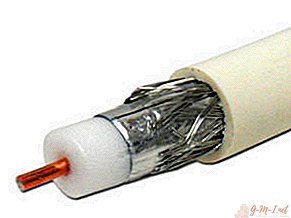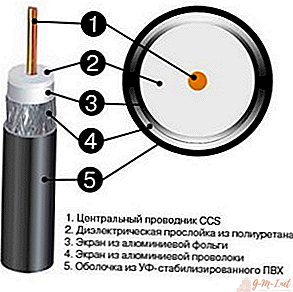Of course, if you are going to purchase a device such as a TV, you need to first deal with the analysis of cable varieties. Several models are distinguished, depending on the type of connection. Therefore, in this article we will try to consider each of them in detail, as well as find out which one is most suitable for a particular design.

Types of antenna cables
Now we will analyze the most common models that are most often found on the shelves. They are presented below:
 RG-6. It acts as a coaxial cable, with the help of which high-frequency signals are transmitted. As for the composition, it is a core made of copper. Its cross section is equal to one millimeter squared. Speaking about the scope, it is worth noting that it is most often used in the transmission of cable or satellite signals.
RG-6. It acts as a coaxial cable, with the help of which high-frequency signals are transmitted. As for the composition, it is a core made of copper. Its cross section is equal to one millimeter squared. Speaking about the scope, it is worth noting that it is most often used in the transmission of cable or satellite signals.- RG-57/58. Basically, they differ from each other by such characteristics as resistance of the conductor, resistance to various loads, and also according to the decay time.
Which antenna cable is better to use for a TV
Without even delving deeply into the topic, we can immediately say that the most popular and really high-quality brand is from Cavel. This explains, at a minimum, that this company has been on the market for a little less than 50 years. Therefore, for such a long period of production of television products, workers have definitely learned to perform the most reliable product. Moreover, the user will receive not only a standard set of advantages: excellent image quality and design of the entire device, but also a number of other advantages. We bring to your attention the following advantages:
- Workmanship. Every detail is so professionally made that the useful life is involuntarily extended.
- All possible connections guarantee excellent contact.
- Despite the fact that the object itself is quite thick and durable, it is not difficult to hide it.
Criterias of choice
It is recommended to disassemble this aspect tentatively by dividing it into several parts. So, what you should definitely pay attention to:

Marking. It is directly on the outer surface. Here you can find the following characteristics: manufacturer, number of cores inherent in a product, quality, resistance and, of course, footage.
- Therefore, the last of these criteria is designed exclusively for 75 ohms. The same indicator should be on the TV. If the parameters do not correspond to each other, then the quality of the reproduced image can significantly decrease.
- Central conductor. As for his material: of course, it would be better if it is made of copper. To determine the composition is easy - by cut. Its color should be silver. ATTENTION! Diameter is also important. At higher rates, the picture will be reproduced without interference even at the farthest distance.
- The more braided hairs, the better it will be to show TV.
- A high-quality screen is made of foil, which protects it from external influences.
Satellite, cable, digital TV - which cable to choose
The most appropriate choice should correspond to the following aspects:
- As for the diameter, it was discussed earlier, however, it is still better not to purchase one that is significantly less than 3.5 millimeters. To the question “why?” The answer is higher.
- Many probably know about the product under the name PK-75. This is a completely domestic manufacturer. Despite this, he is not the best of the rest. Since it was made according to the old model, the decay rate is fast enough, so you should beware of it.
- As for advice from specialists, this is an appeal directly to the brand of the object. Give preference to proven companies that have earned the demand of time and a large number of consumers. In addition, you should not be led to an attractive appearance. It often does not match the cost. This kind of product is on the regular market for a truly lower cost. Therefore, it is necessary to rely solely on the characteristics.


 RG-6. It acts as a coaxial cable, with the help of which high-frequency signals are transmitted. As for the composition, it is a core made of copper. Its cross section is equal to one millimeter squared. Speaking about the scope, it is worth noting that it is most often used in the transmission of cable or satellite signals.
RG-6. It acts as a coaxial cable, with the help of which high-frequency signals are transmitted. As for the composition, it is a core made of copper. Its cross section is equal to one millimeter squared. Speaking about the scope, it is worth noting that it is most often used in the transmission of cable or satellite signals.
Leave Your Comment